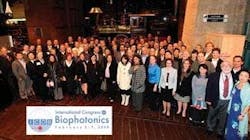Scientists, academicians, and representatives of government and industry spent several days discussing the future of biomedical optics at the first International Congress on Biophotonics (ICOB; Feb. 3-7; Sacramento, CA), sponsored by the NSF Center for Biophotonics Science & Technology (CBST; Davis, CA). Some 125 attendees from Ireland, Scotland, Denmark, Germany, Australia, Taiwan, China, Canada, and the United States heard and gave presentations on key application and technology segments and participated in a number of breakout sessions designed to begin building a strategic roadmap for the future of biophotonics research, technology development, and education.
Attendees learned about major achievements in three areas: advanced microimaging; probes, sensors, and assays; and clinical applications of biophotonics. In addition, they heard presentations about current and projected needs in cancer, infectious disease, cardiovascular disease, regenerative medicine, and neuroscience. Among the highlights:
Prof. Brian Wilson of the University of Toronto gave a plenary talk on the use of photodynamic therapy to treat infectious diseases, providing a “nonantibiotic” treatment approach to bacterial infections.
Prof. Stefan Hell of the Max-Planck Institute for Biophysical Chemistry (Göttingen, Germany) described how his stimulated emission depletion nonlinear microscopy techniques have opened the door to “nanoscopy.” Up to 80-frames/s, 20- to 30-nm-resolution fluorescence nanoscopy is now available, and Leica will soon offer nanoscopes for sale. This level of resolution enables the study of intra- and extra-subcellular organism dynamics without the need for labels.
Neurobiologist Yves de Koninck of Laval University (Quebec, Canada) described his work on studying neuronal function and structure. He challenged the microscopy community to develop high-spatio-temporal microscopy techniques that can achieve high resolution over large-scale lengths (microns to millimeters) and capture images in 1 ms or less.
A panel of representatives from NIH, NSF, AFOSR, DoD, and similar agencies in Canada and the EU discussed their interest in creating new funding initiatives for biophotonics R&D.
Worldwide support
According to Dennis Matthews, director of the CBST and cochair of the ICOB, a clear message to come out of the ICOB is the need to focus biophotonics on some major challenges in bioscience and medicine, he adds. In response to this need, a worldwide initiative, “Biophotonics for Life,” will likely be created as part of the group’s roadmapping efforts. According to Matthews, this initiative will focus resources on such medical challenges as noninvasive measurement of blood glucose, nonantibiotic treatment of infections, revolutionizing pathology by bringing lab diagnostics to the point-of-care, creating better methods of treating presbyopia, providing therapies for metastastic-level cancer, and bringing new methods to emergency medicine for rapid diagnosis and field-portable imaging.
Another important message from the ICOB was the need to develop funding initiatives that encourage large-scale international partnering on biophotonics. According to Matthews, international scientist exchange programs are readily available, but there will be new efforts to create the equivalent of international biophotonics Centers of Excellence or research partnerships. A continuous path for funding of the translation of technology from bench to bedside was also identified as one of the biggest barriers to creating new medical and bioscience devices and tools.
“Our technology readiness levels (TRL scale of 1 to 10, with 1 being ‘concept’ and 10 being ‘marketable device’) mostly fall victim to the ‘valley of death’ (TRL 3 to 7),” Matthews says. “There are many reasons for this, but mostly because there is no NIH-style government or private funding available for getting technology to the stage where it can be commercialized and doing so at entrepreneurial speed. The biophotonics community will now focus on developing initiatives to mitigate this substantial barrier to innovation.”
The ICOB highlighted BiophotonicsWorld.org, a web site recently launched by CBST and the Canadian Institute for Photonic Innovations to serve as a central resource for biophotonics tools, news, and information for researchers, students, teachers, and industry.
The next ICOB will be held in Canada in 2010.
